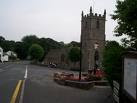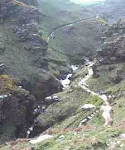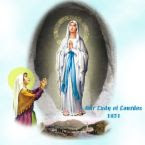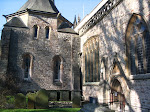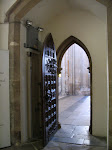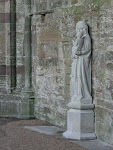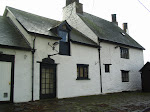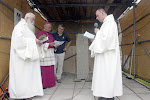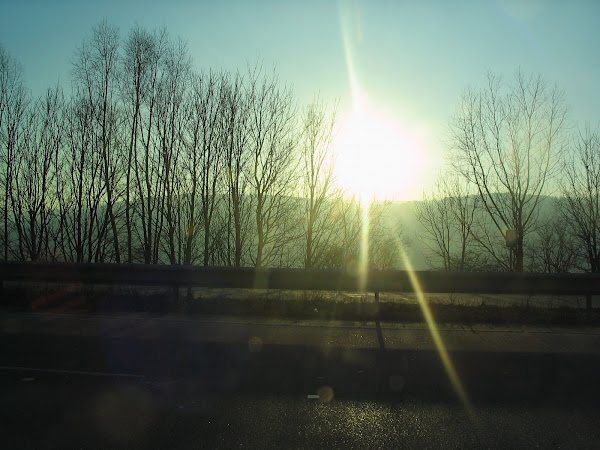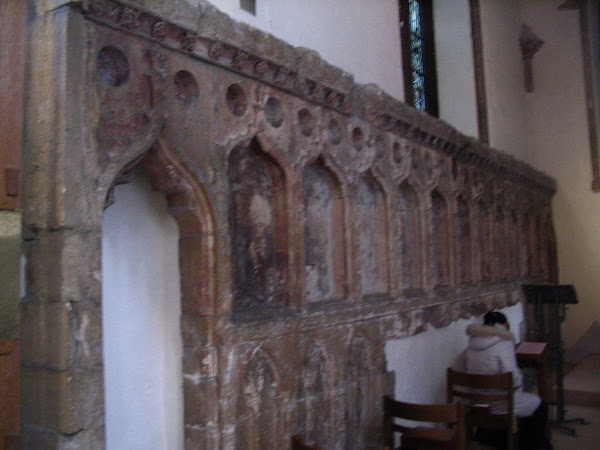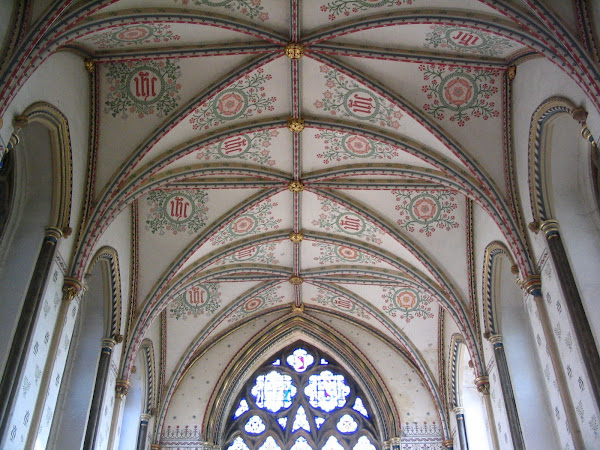http://www.earlybritishkingdoms.com/bios/saints.html
Ciwa (St Kew) with her bear in the beautiful stained glass window in Cornwall. She is holding her church of St Kew, not Llangua.
The photos below show a variety of scenes of Llangua Church and also th site of the mill excavation on the nearby Monnow. It is an exceptionally pretty site. Please leave a donation if you go, although there is no entrance charge. Tea and cakes are served during the August opening hours.Belmont Abbey is nearby and you can book at the refectory for a superb and moderately priced Sunday lunch. The Abbey Church is currently being refurbished.Belmont is only a mile or so from Llangua-turn right to the Belmont Golf Club. The Abbey also has a bookshop with religious goods and lovely gardens.








 _______________________________________________________________________________________________________________
_______________________________________________________________________________________________________________Today and intriguing article about the little Priory of Llankywan, known in Welsh as Llangua. Whilst the land is in the diocese of Cardiff (Belmont Abbey lies a mile up the road and used to be the Cathedral for Newport)it has somehow come into the diocese of Hereford and has been restored in recent times, so this little former Benedictine cell at least lies close to a larger Benedictine Abbey.
Later this week I will discuss its Mediaeval story, the St James features we see inside the church and the superb statue.
What I want to discuss today, is this little priory cell, which was there to administer the surrounding lands, collect tithes and serve the churches up the hill at Grosmont Castle and St Nicholas,with priests. It was here long before the Norman overlords arrived. William FitzOsbern, William the Conqueror's strongest henchman, (who did not last long as I explained in my post on the Benedictine Priory of Our Lady at Chepstow)endowed many of the religious foundations in East Monmouthshire under his Knights to whom he granted lands.
ST CIWA and the LLan or Celtic monastic settlement at Llangua
The earliest we know for certain about the little Priory of Llanciwan is that it was a ‘clas’ church and was doubtless a monastery in Celtic and Saxon times. The circular nature of the wall of the churchyard gives credence to this and Dr Piper, a historian and friend of the church was convinced that the larger stones used in the building of the Priory Church dates to earlier times.
I have already talked about the Catholic church in Celtic times, so it is possible that small wooden or mud and wattle buildings were on the site and were taken over in later times by Saxons who may have put up a stone church before The tub front of the church is Norman and the interior porch doorway is round-headed. There are a number of unrestored perpendicular windows, and a blocked priest hole. The tower is half timbered with a row of turned balusters below the pyramidal roof with a gold weather cock.
Saint Ciwa, Saint Kew(also called Ciwa, Kuet, Kywere,Kywan) Foundress-Llangua and St Kew (Landow)
So who was St Kew? If you’ve been to Cornwall (Kerniw) you probably will have seen the village and church of St Kew on the A 39 Atlantic Highway.Her brother St Docheu of Docco(of Llandogo near Tintern)would have nothing to do with her until she tamed a bear, though more recent tradition says that she inspired the locals to hunt it down and kill it).
Ciwa was thus allowed to build herself a small hermitage and chapel near her brother's, but she wisely chose to go further away to a site more protected from wildlife attacks.
She died on 8th February (year unknown)ibn the sixth century and was subsequently remembered more fondly than Dochau. The present village of St. Kew in Cornwall grew up around her church. She may have founded Llan-ciwa as her first foundation, as no doubt she died at the one at Llanow. Her monastery at St Kew was de-spoiled by King Edgar in about 958-975AD during the Saxon invasion of Cornwall.
As so many Welsh saints, she was a traveller and no doubt after her first years at Llangua,she perhaps travelled closer to her brother, down to Cornwall and took over her 'llan' at what is now St Kew, and formerly had been her brothers'foundation.It is also possible, that, as Saxons began to attack the Welsh borders, she travelled to Cornwall for safety's sake.
ST DOCHAU of LLAN-DOGO-Also Docco and Oudecaus-later Bishop-nephew of St Teilo
St Dochau was a hermit monk doing his ‘Green Martyrdom’ at 'Llan-Dogo' and in ancient writings said that St Ciwan came to visit him there , whilst doing her own ‘white martyrdom’. (Travelling to do the will of God wherever it took her) Dochau would not receive her until ‘he sawe a wild boar miraculously obeye her’.
We learn from Dochau that he found she had become such a pattern of goodness, humility and gentleness that she became to be revered and accepted as a saint by the local communities at Llangua and St Kew, and it is fitting that her monastic foundation in Wales is still there in the village's name to this day..
St CIWA's FEAST is on 8th February
In the Welsh Calendars, St Ciwa’s feast is on 8th of February. This is one feast day which should be remembered by the people of Llangua, and St Kew, (which used to be known for her brother in Cornish-Llandow) The little Welsh girl who came to both remote places to love and serve the Lord, where she could be at peace and grow in Christ's will, not being distracted by the ways of the world. No doubt she attracted others who felt likewise.
For fuller information on the Celtic monasteries and clas churches and Celtic Catholic traditions, please go to the blog on St Cadoc on the links to 2007 below on the left hand column.
On visiting the Church you can see that the floor of the church has been raised several times, possibly because of flooding. The Celtic Catholic religious who first built the site, would have been aware of the holiness of St Kew and would have
been inspired by her example.
Llankywan
The dedication to St James seems to have been much later-possibly in Mediaeval times, as even when Henry the VIII men came to seize this little priory,it was called the Pryorie of Llankywan in Monmouthshire. So Ciwa's name has prevailed in the name of the nearby village - Llan-gua (ciwa).
My Visit
This church has been restored by the 'Friend of Friendless Churches' and is only open one Sunday of the month for an Anglican Service at 8.30am. It is open during August every Sunday afternoon and it is an idyllic church in an idyllic spot and some very friendly people provide refreshments in the church, which is next to the river, where the monks mill site has been recently excavated.
This little church has one enormous secret, and one of which Catholics should be proud- but I'll go into that in a subsequent post!
Next: Llangua (south of Pontrilas south of Hereford on the river)




















